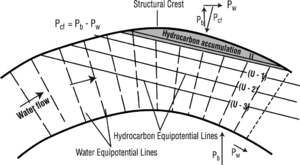Hydrodynamic influence on trapping
| Exploring for Oil and Gas Traps | |

| |
| Series | Treatise in Petroleum Geology |
|---|---|
| Part | Critical elements of the petroleum system |
| Chapter | Formation fluid pressure and its application |
| Author | Edward A. Beaumont, Forrest Fiedler |
| Link | Web page |
| Store | AAPG Store |
Hydrodynamic influence on trapping
Potential of water vs. hydrocarbons
Fluid pressure equals pgH. Under hydrostatic conditions, the buoyant force equals
where:
- ρw = water density
- ρh = hydrocarbon density
- Hw = water depth
- Hh = hydrocarbon column height
Under hydrodynamic conditions, the potential for a hydrocarbon column (Φh) is related to the potential of the water by the equation
Dividing through by g (ρw – ρh)/ρh to simplify gives (in a uniformly flat gravity field)
Constant values for the left-hand side of the equation are equipotential surfaces for hydrocarbons. Hubbert[1] called this factor U. From the right side, constant values for ρw/(ρw – ρh)Hw are equipotential surfaces for water. Hubbert called this factor V. The elevation factor (Z) is the difference between the equipotential surfaces for hydrocarbons and water.
Substituting U and V in the above equation gives
Fluid flow is perpendicular to equipotential surfaces.
Hydrodynamic effect on traps

In a hydrostatic environment, the free-water level of a trap is horizontal. In a hydrodynamic environment, the free-water level of a trap is tilted because the buoyant force (Pb) is interfered with by the hydrodynamic force (Pw). The resultant interference is the vector known as the confining force (Pcf). U, an equipotential line, is perpendicular to Pcf and is tilted because of the effect of Pw. The diagram in Figure 1 shows these vectors and the equipotential lines for a hydrocarbon accumulation in an anticline in a hydrodynamic environment.
See also
References
- ↑ Hubbert, K., 1953, Entrapment of petroleum under hydrodynamic conditions: AAPG Bulletin, vol. 37, no. 8, p. 1954–2026. The original paper that proposed hydrodynamics as an important trapping mechanism.
- ↑ North, F. K., 1985, Petroleum Geology: London, Allen & Unwin, 246 p.



